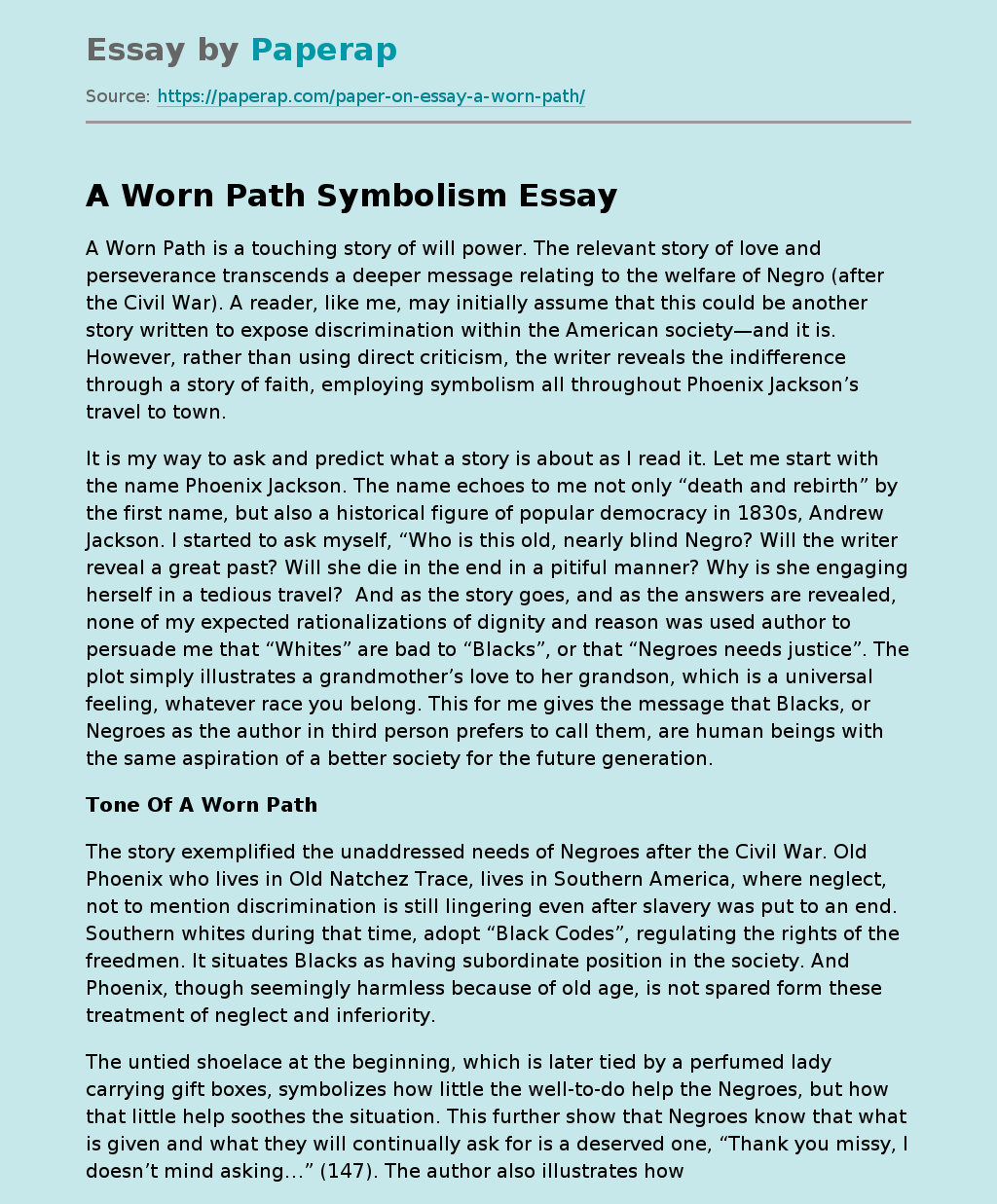A Worn Path Symbolism
A Worn Path is a touching story of will power. The relevant story of love and perseverance transcends a deeper message relating to the welfare of Negro (after the Civil War). A reader, like me, may initially assume that this could be another story written to expose discrimination within the American society—and it is. However, rather than using direct criticism, the writer reveals the indifference through a story of faith, employing symbolism all throughout Phoenix Jackson’s travel to town.
It is my way to ask and predict what a story is about as I read it. Let me start with the name Phoenix Jackson. The name echoes to me not only “death and rebirth” by the first name, but also a historical figure of popular democracy in 1830s, Andrew Jackson. I started to ask myself, “Who is this old, nearly blind Negro? Will the writer reveal a great past? Will she die in the end in a pitiful manner? Why is she engaging herself in a tedious travel? And as the story goes, and as the answers are revealed, none of my expected rationalizations of dignity and reason was used author to persuade me that “Whites” are bad to “Blacks”, or that “Negroes needs justice”.
The plot simply illustrates a grandmother’s love to her grandson, which is a universal feeling, whatever race you belong. This for me gives the message that Blacks, or Negroes as the author in third person prefers to call them, are human beings with the same aspiration of a better society for the future generation.
Tone Of A Worn Path
The story exemplified the unaddressed needs of Negroes after the Civil War. Old Phoenix who lives in Old Natchez Trace, lives in Southern America, where neglect, not to mention discrimination is still lingering even after slavery was put to an end. Southern whites during that time, adopt “Black Codes”, regulating the rights of the freedmen. It situates Blacks as having subordinate position in the society. And Phoenix, though seemingly harmless because of old age, is not spared form these treatment of neglect and inferiority.
The untied shoelace at the beginning, which is later tied by a perfumed lady carrying gift boxes, symbolizes how little the well-to-do help the Negroes, but how that little help soothes the situation. This further show that Negroes know that what is given and what they will continually ask for is a deserved one, “Thank you missy, I doesn’t mind asking…” (147). The author also illustrates how discrimination is not totally intentional, but that it is deeply rooted in the culture. For how can a woman, who simply ties the shoe lace and then leave the old Phoenix, be regarded as nice?
The woods represent the life Negroes are facing. The author inspires the readers through Phoenix, that though she seems inapt, she pursues her goal. She relies on her knowledge about the terrain. This provides the irony that the former slaves, who knew better than their white masters about the work and the place, do not get their proper due. Phoenix, even if almost blind, know the place so well, she could “own” it. As she walks slowly, she warns the animals, “Keep out from under these feet… I got a long way” (142). The marble cake in a plate represents how the offer of Southern consolidation is just ‘a piece of cake’, when she replies, “that would be acceptable”. But then it appears be a rhetorical offer, “when she went to take it there was just her own hand in the air” (143). Indeed, the struggle to achieve human rights took a long while; discrimination persists even after the millennium.
The encounter with the white hunter shows how Phoenix action is just an unfruitful play to the young man, “I know you old colored people! Wouldn’t miss going to town to see Santa Claus” (144). It also shows how Phoenix used the hunter’s boastfulness “Watch me get rid of that cur (146), to get what she wants—the nickel. This is a representation of how the whites try to frighten the blacks away from their struggles, by showing off that whites can protect them, “and then he laughed and lifted his gun and pointed it at Phoenix.” (146)
When Phoenix finally arrived at he doctor’s place, she stood watching “the document that had been stamped with the gold seal and framed in the gold frame, which matched the dream that was hung up in her head”(147). Later she directly clears the Negroes anticipation to avail other rights as good education, “I never did go to school, I was too old at the Surrender.” (148.)
Then, Phoenix reminds the reader that no matter how the trip took so long, the Negroes must not forget the reason of their struggle, “I remember so plain now. I not going to forget him again, no, the whole enduring time. I could tell him from all the others in creation (148). This my favorite line, when Phoenix states that her grandson will benefit from all the hardships. She then sets off to buy him a paper windmill, “He going to find it hard to believe there is such a thing in the world” (149). The author ends it in an optimistic tone of hope, that the coming generation will fully value the efforts of the past, as nothing in the world can ever offer.
A Worn Path Symbolism. (2019, Dec 05). Retrieved from https://paperap.com/paper-on-essay-a-worn-path/

